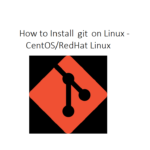AWS Systems Manager Patch Manager automates the process of patching managed instances. In the last article, we have seen how to use the predefined baselines for windows and Linux instance patching using the “Patch now” method. In this article, we see how to group the instances and schedule the patching based on the patch group. […]
Linux
Holistic Operational Management – AWS Systems Manager
AWS Systems Manager helps you manage your EC2 instances and On-Premise systems at scale. You can easily get operations insights about the state of your infrastructure. It helps to detect instance issues easily and also it could be patching automation solution to enhance compliance. AWS Systems Manager works for both windows and Linux operating systems […]
How to generate a CSR file to get a valid SSL certificate?
How to generate a CSR (certificate signing request) file to produce a valid certificate for web-server or any application? This article will walk you through how to create a CSR file using the OpenSSL command line, how to include SAN (Subject Alternative Names) along with the common name, how to remove PEM password from the generated […]
Cleanup all Docker containers using a single command
How to stop all the docker containers? How to destroy docker containers quickly? How to remove all the downloaded docker images? Very often we deploy the containers for testing and spend time cleaning up the containers one by one. This article will provide quick commands to stop all the running containers and delete them quickly. […]
Install and configure Git client on RHEL 7 /CentOS 7?
Install and configure Git client on RHEL 7 /CentOS 7? Git client is a very useful command-line utility to manage git repository from Linux. Git is the most popular distributed version control and source code management system. This article will walk you through how to install git on CentOS 7/ RHEL 7. It also walks […]
Ansible reboot module – Shutdown Command Not found on Linux
Ansible is a widely used configuration management tool. Opensource community and RedHat aggressively developing to create modules for each task. In Ansible 2.7, reboot module is responsible to reboot the host and wait to come back. But the Linux image development varies for each organization. In some environment, engineers might remove shutdown command from the […]
Ansible – Reboot Server Using Playbook and Wait for come back
Ansible is a simple configuration management tool. Open source community keeps trying to make the code much simpler on the newer version. Prior to Ansible engine 2.7, To reboot the target hosts, we need to define a block of code to reboot the server and wait until the hosts to come back. Most of the time. making the configuration changes or installing […]
VxVM – Disk group has no valid configuration copies
Veritas volume manager is robust volume manager software and mostly used on Oracle Solaris, HP-UX and Linux Operating systems. In some cases, after the host reboot, you might get an error that “Disk group has no valid configuration copies” when you try to import the existing Veritas disk group. This error common in SRDF environment […]
How to find Linux is under BIOS or UEFI mode ?
How would you find your Linux server booted in BIOS mode or UEFI mode? What’s the main difference between BIOS and UEFI? Servers which had shipped prior to the 2011 year have only BIOS firmware installed by default. BIOS is legacy firmware used only on X86 hardware and its 16-bit code. BIOS will take more time for […]
How to Merge/Update Redhat Linux YUM Repositories ?
Redhat Linux YUM repository is useful for installing packages , updating the packages and upgrade the operating system with automatic dependency selection method. In larger environment , we need to setup the repository via HTTP to make the YUM repository to be available over network. At the same time , you might have different RHEL […]









